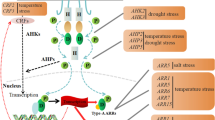Summary
The net uptake and movement of radioactivity by 12-mm root segments of Zea mays have been studied as a function of time at 5, 15 and 25° C. Segments were supplied with an agar donor block containing 1 μM IAA-1-14C or IAA-2-14C continuously or for a limited period of time (pulse-labelling). In the latter case the original donor block was replaced either by a plain agar block or by one containing 1 μM unlabelled IAA. Receiver blocks were placed at the other end of the segments.
The net uptake of radioactivity from the donor block at 15° C was greater at the basal end than at the apical end of the segment. At 5 and 15° C, the net uptake from a basal donor was virtually linear with time but at 25° C the rate of net accumulation decreased after about 10 h. Decarboxylation of IAA undoubtedly occurred at 15 and 25° C when the concentration in the tissue attained a high value.
An acropetally polarised movement of radioactivity into the receiver blocks occurred regardless of whether the results were based on the actual amounts of radioactivity in the receiver block, or on the amounts in the receiver block expressed as a percentage of the net total radioactivity accumulated from the donor block. Only one radioactive substance was present in the receiver block and it ran to the same Rf as IAA in the isopropanol: ammonium: water solvent system.
The amounts of radioactivity moving into that part of the root segment at least 6 mm distant from the end in contact with either an apical or a basal donor block were assessed. An acropetal polarity in the movement of radioactivity was observed on the basis of the actual amounts of radioactivity in these distal parts of the segments, but no such polarity was evident when the amounts of radioactivity were expressed as a percentage of the net total accumulated from the donor block. At least 3 radioactive substances were present in the tissue in addition to the substance running to the same Rf as IAA. The distribution of radioactivity in the segment cannot therefore be used to assess the distribution of IAA.
Acropetal movement of radioactivity into an apical receiver block is not dependent upon the continued uptake of IAA at the basal end of the segment. No distinct pulses of radioactivity were detected moving through the root segments.
Only a small part of the radioactivity in the root segment appears to be located in the polar transport system, while the bulk is not. The polarity found in the movement of the bulk radioactivity within the segment seems to be related to the polarity in IAA uptake from the donor blocks.
Similar content being viewed by others
References
Bonnett, H. T., Torrey, J. G.: Auxin transport in Convolvulus roots cultured in vitro. Plant Physiol. (Lancaster) 40, 813–818 (1965).
Bowen, M. R., Cane, A. R., McCorquodale, I., Wilkins, M. B.: Auxin transport in roots. VIII. The distribution of radioactivity in the tissues of Zea root segments. Planta (Berl.) (in press) (1972).
Cane, A. R., Wilkins, M. B.: Auxin transport in roots. VI. Movement of IAA through different zones of Zea roots. J. exp. Bot. 21, 212–218 (1970).
Goldsmith, M. H. M.: Movement of pulses of labelled auxin in corn coleoptiles. Plant Physiol. (Lancaster) 42, 258–263 (1967).
Goldsmith, M. H. M.: Comparison of aerobic and anaerobic movement of 3-indole-acetic acid in coleoptiles of corn and oat. Biochemistry and physiology of plant growth substances, ed. Wightman, F., Setterfield, G. Ottawa, Canada: Runge Press Ltd. 1968.
Good, N. E., Andreae, W. A., Ysselstein, M. W. H. van: Studies on 3-indoleacetic acid metabolism. II. Some products of the metabolism of exogenous indoleacetic acid in plant tissues. Plant Physiol. (Lancaster) 31, 231–235 (1956).
Kirk, S. C., Jacobs, W. P.: Polar movement of indole-3-acetic acid-14C in roots of Lens and Phaseolus. Plant Physiol. (Lancaster) 43, 675–682 (1968).
Sabnis, D. D., Audus, L. J.: Growth substance interactions during uptake by mesocotyl segments of Zea mays L. Ann. Bot. 31, 263–281 (1967).
Scott, T. K., Wilkins, M. R.: Auxin transport in roots. II. Polar flux of IAA in Zea roots. Planta (Berl.) 83, 323–334 (1968).
Scott, T. K., Wilkins, M. B.: Auxin transport in roots. IV. Effect of light on IAA transport and geotropic responsiveness in Zea roots. Planta (Berl.) 87, 249–258 (1969).
Wilkins, M. B., Cane, A. R.: Auxin transport in roots. V. Effects of temperature on the movement of IAA in Zea roots. J. exp. Bot. 21, 195–211 (1970).
Wilkins, M. B., Cane, A. R., McCorquodale, I.: Auxin transport in roots. IX. Movement, export, resorption and loss of radioactivity from IAA by Zea root segments. Planta (Berl.) (1972) (in press).
Wilkins, M. B., Scott, T. K.: Auxin transport in roots. Nature (Lond.) 219, 1388–1389 (1968a).
Wilkins, M. B., Scott, T. K.: Auxin transport in roots. III. Dependence of the polar flux of IAA in Zea roots upon metabolism. Planta (Berl.) 82, 335–346 (1968b).
Author information
Authors and Affiliations
Rights and permissions
About this article
Cite this article
Wilkins, M.B., Cane, A.R. & McCorquodale, I. Auxin transport in roots. Planta 105, 93–113 (1972). https://doi.org/10.1007/BF00385571
Received:
Issue Date:
DOI: https://doi.org/10.1007/BF00385571




